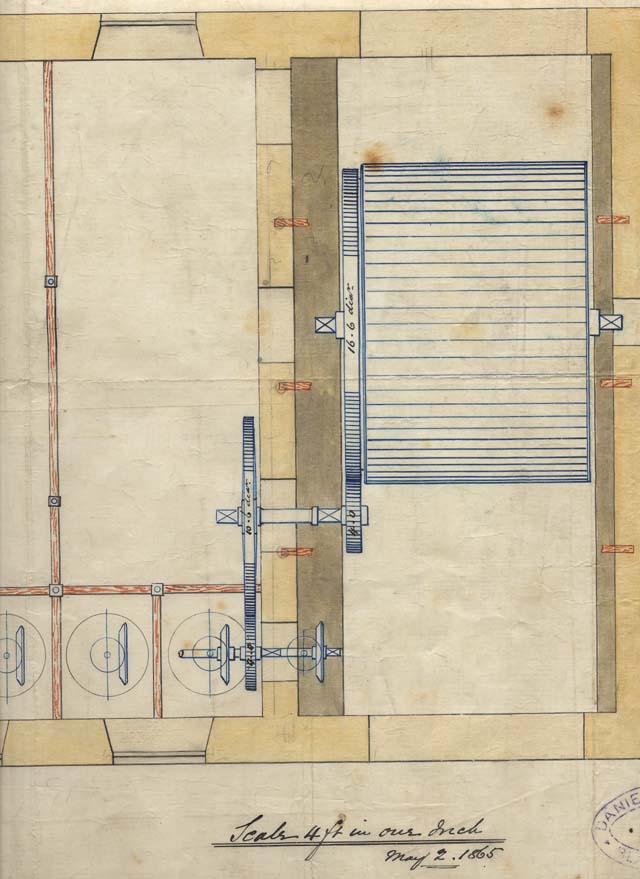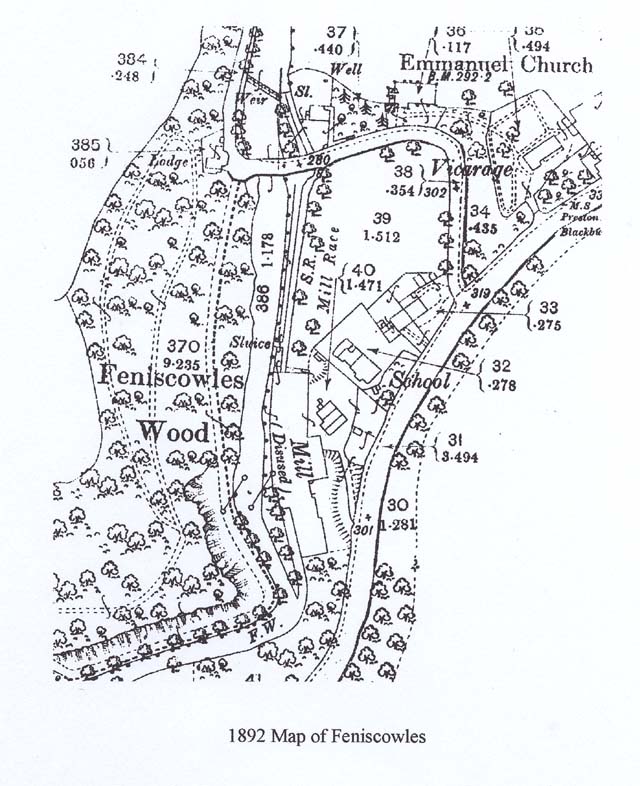Corn Milling
Corn milling was the earliest mechanised industry in Blackburn and water-powered mills are known to have existed during the medieval period. These were manorial or soke mills which drew tithes and rents for their use. At least three sites survived into the nineteenth century, although the actual buildings were restored at various times.
Steam driven mills, and one windmill, were erected in the first half of the nineteenth century, mostly along the banks of the Leeds and Liverpool Canal. Oat crushing was a major function of these mills, although flour production became increasingly important. The smaller mills, in particular, were also concerned with processing animal feedstuffs. A significant change occurred in the 1880s with the introduction of roller milling. A direct consequence of this was the closure of the smaller operations using grinding stones. The two large flour mills of Blackburn at Daisyfield and Audley continued working until the middle of the twentieth century when transport and economic factors led to the end of large scale milling in the town.
By Mike Rothwell
A Walk Mill, or fulling Mill as it is sometimes called, stood on the Livesey side of the River Darwen more than five centuries ago. Gyles Livesey, in possession of the manor of Livesey before 1520, was the owner. James Livesey, his descendant, who died in 1619, held the manor which included ten messuages, six cottages, one Fulling Mill and lands.Farmers, yeomen etc. would bring their woollen pieces woven on handlooms, to be "milled" (shrunk) before trading them in Manchester or Bolton.
The manufacture of woollen materials became less profitable around the end of the 18th century and it may have been about that time that a corn mill replaced the old Walk Mill. A present day reminder of its existence is Walk Mill Bridge, connecting the township of Livesey and Pleasington over the River Darwen. The bridge was evidently the responsibility of Pleasington, for a new bridge, constructed in 1722, was built and paid for by the township.
William Pickup, miller of Moulden Water Corn mill before 1782, gave up the occupation of the mill, when his employer Oswald Pilling, corn merchant and chapman became bankrupt in October 1802. The mill houses and land in the vicinity of Walk Mill Farm were, along with other properties in Livesey, offered to be let on October 27th 1802. Prior to 1782 the Rev Daniel Wilson and his wife Elizabeth were the chief property owners in Livesey. The mill is mentioned in 1786 as the property of the 'Lady Elizabeth,' daughter of the late William Livesey Esq. of Livesey Hall and relict of the late Rev Daniel Wilson of Lancaster. Mrs Wilson died at Hest Bank, near Lancaster, aged 72 on the 20th October 1801.
Henry Feilden of Witton and William of Feniscowles within Pleasington, between them, purchased the Manor of Livesey in 1805. As a result the Moulden Water district, part of William’s land, being on the west side of Livesey Hall, soon became known as Feniscowles.
Moulden Water Mill with kiln and one cottage was offered to be let along with several farms in Livesey on January 7th 1807. 'Anyone desiring particulars will apply at the counting house of Henry and William Feilden in Blackburn.' The corn mill (rebuilt by Daniel Wilson Esq. around 1784) was then in the control of John Heatley, who lived in the adjacent cottage.
In September 1815 the mill, drying kiln and miller's house, once again came vacant. The mill works consisted of – three pair of grey stones, two pair of French Burrs, two flour machines, one wheat screen, rollers for crushing malt, and a waterwheel 17 feet in diameter and over 12 feet wide, powered by a powerful stream of water. Applications to view the corn mill one-quarter of a mile from Leeds and Liverpool Canal were to be made to Robert Dugdale, Brown Street, Blackburn.
John Polding and Richard Walker, corn millers, each with shops and premises in Darwen Street, Blackburn, were both concerned in the running of Livesey corn mill before 1825. Richard Holt was possibly miller in charge before 1831, when he resided in the house nearby.
Richard Walker, living at Rose Hill, Pleasington before 1843, held a vote for the town of Blackburn on account of his house and shop in Darwen Street. Between the years 1832 and 1844 as occupier of a corn mill, warehouse etc, at Moulden Water he apparently also had a vote for Livesey Township. Mr Walker retired from business in 1846. A month of so earlier, the property, described as 'a powerful corn mill in Livesey,' was advertised to be let, by proposal for a term of years. The mill was said to be 'a short distance from the populous town of Blackburn and peculiarly well adapted for a large quantity of work.' With the mill were to be let three dwelling houses and stables. In the Blackburn Standard, January 21st 1846, the water corn mill known as Livesey Mill in Livesey, with drying kiln, four pairs of French Burrs, two pairs of grey stones, and machinery on 'the most improved principles' was publicly announced again to be let.

The first offer was made on January 7th; proposals in writing were to be forwarded to Mr Romney of Feniscowles, agent to William Feilden Esq. In July that year Sir William Feilden, owner of the building received his baronetcy.During his term of almost 20 years James Ellison, the next miller, installed new machinery and made several other improvements.
A disastrous event happened early on Friday morning, 18th of November 1864 - an extensive fire in Livesey corn mill. The whole of the four-storey building was completely gutted, before assistance could be rendered. A carter named Smith in the employment of Mr Ellison first discovered the fire on his way to work. He immediately roused Mr Ellison and was instructed to carry the alarm to the Blackburn police office and obtain the assistance of the fire brigade. It was reported that:
'the stupid fellow, notwithstanding that three horses were stabled in adjoining stables, trudged off to Blackburn on foot and not at a very rapid pace apparently, for it was half past six before the information reached the Chief Constable. The fire bell was immediately rung and two engines sent to the spot, horses having been procured without loss of time at the White Bull Hotel.'
Only the walls of the Mill were left standing; all machinery was destroyed. The building, insured for £1000, was damaged to the extent of £2000. Machinery was insured for £7000, which did not cover the loss. Complete destruction prevailed.
Within four years of the fire Sir William Henry Feilden erected a new corn mill, and in 1868 he dismissed it to J. & W. Kitchen for a term of 14 years at a rent of £130 payable in advance.
In January 1870 James Jones became partner with the Messer’s Kitchen. It was arranged between the lessees and Mr West, the steward and agent to Sir William H. Feilden, that Sir William should give, as a guarantee to the Manchester and County Banking Company, a sum of £800, and that 'an inventory and valuation of certain stones, and gearing and machinery taken in the mill by the leases,' should be made by two valuers, one appointed by Sir William, and the other by the lessees. This was done on 14th April 1870.
During April 1872 Sir William H. Feilden and Mr Kitchen took an appeal to court, following legal action taken against Blackburn Corporation for polluting the River Blakewater that joins the River Darwen at Witton by turning the town’s sewage into these streams. Mr Kitchen in his evidence said:
'We have a waterwheel at the mill, and I have often found it clogged with hard substances. We have to keep the wheel going or it would be choked up. When the mill is not working we have to open the sluice and goit and let the water run by. I regard the matter which comes down the water as human excrement which goes down in masses and stops at the bottom.'
Sir William and his son Major William Leyland Feilden sued Blackburn Corporation, but lost the case.
Twelve months later J. & W. Kitchen and James Jones were in financial difficulty, but they continued to work the mill. They remained in the possession and control of the machinery up to 16th September 1873. On this day they filed their petition of liquidation, stating that Sir William H. Feilden had not paid the promised £800. A charge was made against him. The affair ended with the cost of both parties coming from the estate.

Livesey Corn Mill, with the waterwheel, second motion wheel and pentrough, the mill dam, water implements, fixtures and appurtenances belonging, were never again used for the purpose of grinding corn.Trading as Feniscowles Paper Mill Co, a number of businessmen acquired the land and buildings for the manufacture, sale and printing of paper. They registered on the 30th September 1873. With capital of £30,000 in 30 shares of £1000 each; the first subscribers were, J. Gregson, Lower Darwen, cotton manufacturer; J. Tomlinson, Over Darwen, coal merchant; J. Cooper, Over Darwen, coal merchant; J. Harwood, Over Darwen, papermaker; J. Carter, Blackburn, coal merchant; E Monk, Blackpool farmer; William Tomlinson, Over Darwen, coal merchant. Each of these gentlemen had one share.

Early in March 1881 the Manchester and Blackburn Paper Mills,was formed to take over Feniscowles Paper Mill with a view to developing the business on a more extensive scale, being one mile from Feniscowles Station and one mile from Pleasington Station, there could be no question that it was advantageously situated for paper-making.
The Feniscowles Company failed. The building known as a Feniscowles Paper Mill was offered for sale on Wednesday 27th September,1882, built of brick and stone, it comprised, entrance, watch house, office, storeroom, smithy, mechanics shop, two-storey paper store and cutting room, machine house for two large machines, washing and beating houses, bleaching, chopping and storerooms, chemicals store, boiler house, two engine houses, chimney, three-storey building forming a storeroom for the new material, and other necessary buildings.
The sale was to be held at the Old Bull, Blackburn.
There is no evidence to confirm that the buildings were known as Moons Mill although had the Manchester and Blackburn Company taken over the premises, they possibly had that name in mind.
Apparently the mill never worked again, its ruins, not exactly on the site of the old Walk Mill, are all that is left of a once busy little bit of Livesey.
By David M Starkie

